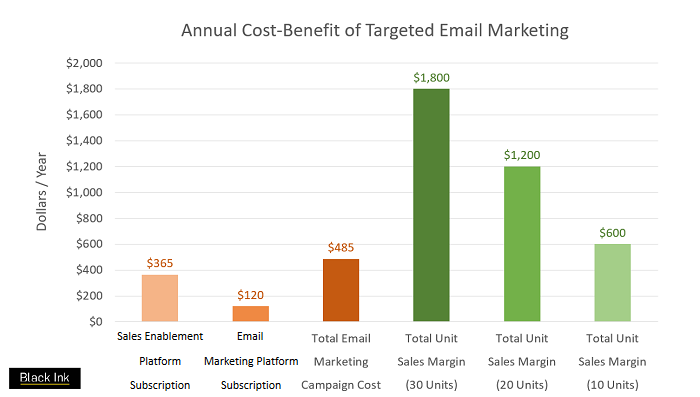How an Integrated Customer Data and Analytics Platform Can Boost Email Marketing
by Black Ink Team
By integrating your organization’s customer information database with analytics tools, you can greatly save on cost for implementing targeted marketing campaigns. To illustrate, here is an example of an email marketing strategy that is made possible when you have a single platform which you can use to filter customer lists, identify cross-sell opportunities, and communicate directly with customers.
Let’s say that you are selling a new model of product X, the old model is nearing the end of its lifecycle, and you want to run a promotion to boost sales. Specifically, you wish to target customers who:
- live where product X has undersold
- have already bought related product Y
- OR own an older model of product X
The first step would be to conduct analysis to generate lists of customers who fit the target description - lists you will then use to send out personalized emails (possibly with enticing discounts or other incentives included). Here is where an integrated customer analytics and marketing platform becomes useful.
Without an integrated platform, your customer information likely lives in silos: 'Data silos' are collections of useful data that are stored in not-so-useful ways. For instance, your organization could be relying on multiple on-premise customer information databases situated at each of your distributors. Or worse, you could be using multiple referencing techniques to organize each database – in which case, the collected data will have to be reorganized from scratch. The analysis step would be much more time-consuming as a result, since when you finally get done making copies of all the necessary data you will still unfortunately have a long way to go.
Instead, if everything were in the cloud in one, streamlined customer database, you could sign on to one platform and get to work right away. Without needing to migrate any data, find and delete duplicate data, or manually match customer IDs you could immediately factcheck which zip codes have the least product X sold nationwide. Then, from there you could simply filter those results to pinpoint which leads would be the most advantageous to use for your promotion.
Even sending the actual emails can be done using the same business software. Time to completion? With an integrated platform you can find the perfect group of customers for a targeted promotion in less than 10 minutes and blast emails out to them in under 5. On the other hand, you could spend days sitting patiently while the necessary files get transferred from data silo to data silo.

Since numbers don’t lie, let’s crunch them. If your targeted email marketing yields 30 extra unit sales a year at a $60 margin per unit (20% margin at $300 retail), that’s a total unit sales margin of $1,800 anually. Next, we subtract costs: If you're a single-location dealer, that's a $1/day subscription for a customer analytics and sales enablement platform (e.g., EyeOn Customer), in addition to a $10/month subscription for an email marketing solution. All told that’s $1800 - $365 - $120 = $1315 in margin. Keep in mind that’s gained only from spending fifteen minutes a few times a year. For a conservative estimate, even if you only sold 10 extra units through this initiative, you'd still net $115 (see chart above).
With other marketing channels the story is the same, which is to say: Having all of your customer information available in one location AND being able to link it to analytics plus other tools means faster workflows and better results.
